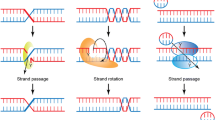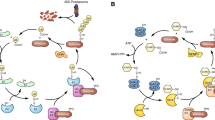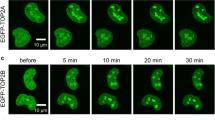Abstract
Purpose
DNA topoisomerase II (topo II) is an important cellular target for chemotherapeutic agents. Human cells have two isoforms of topo II (α and β), and both are inhibited by the chemotherapeutic agents etoposide, amsacrine (mAMSA) and mitoxantrone. It is known that the cytotoxic importance of topo IIα or topo IIβ drug-induced complexes differs depending on which drug is present. This study was designed to (a) assess isoform-specific formation and reversal of topo IIα and β cleavable complexes, and (b) determine whether the cytotoxic importance of either isoform was related to differences in the longevity of the complexes.
Methods
Mouse embryonic fibroblasts (MEFs) were used to study the cellular response to the topo II poisons etoposide, mitoxantrone and mAMSA. The longevity of topo IIα and β complexes was determined using the TARDIS assay. This immunofluorescence assay can differentiate between the topo II isoforms and thus allowed us to investigate the persistence and importance of topo IIα and β complexes for the first time.
Results
In MEFs treated with etoposide, 50% of topo IIα complexes dissociated within 40 min whereas dissociation of topo IIβ complexes took only 20 min. Disappearance of complexes was a slower process for mitoxantrone-treated cells. The time taken to reduce topo IIα and topo IIβ cleavable complexes by 50% was 10 and 6 h, respectively. In contrast, mAMSA-stabilized topo IIα and topo IIβ cleavable complexes were equally stable (dissociation within 15 min for both isoforms). These stability data were confirmed using an in vitro assay.
Conclusions
We previously demonstrated that topo IIα is the major target for etoposide and mitoxantrone but that both topo IIα and topo IIβ are important for mAMSA cytotoxicity. The longevity of the topo IIα and β cleavable complexes shown here is therefore an important factor in determining the cytotoxic sensitivity of either isoform to these drugs.






Similar content being viewed by others
Abbreviations
- FITC:
-
Fluorescein isothiocyanate
- mAMSA:
-
Amsacrine
- PBS:
-
Phosphate-buffered saline
- TARDIS:
-
Trapped in agarose DNA immunostaining
- topo:
-
Topoisomerase
References
Austin CA, Marsh KL (1998) Eukaryotic DNA topoisomerase IIβ. Bioessays 20:215
Austin CA, Sng J, Patel S, Fisher LM (1993) Novel HeLa topoisomerase II is the IIβ isoform: complete coding sequence and homology with other type II topoisomerases. Biochim Biophys Acta 1172:283
Bailly JD, Skladanowski A, Bettaieb A, Mansat V, Larsen AK, Laurent G (1997) Natural resistance of acute myeloid leukemia cell lines to mitoxantrone is associated with lack of apoptosis. Leukemia 11:1523
Caldecott K, Banks G, Jeggo P (1990) DNA double-strand break repair pathways and cellular tolerance to inhibitors of topoisomerase II. Cancer Res 50:5778
Capranico G, Binaschi M (1998) DNA sequence selectivity of topoisomerases and topoisomerase poisons. Biochim Biophys Acta 1400:185
Chen C, Fuscoe JC, Liu O, Relling MV (1996) Etoposide causes illegitimate V (D) J recombination in human lymphoid leukemic cells. Blood 86:2210
Covey JM, Kohn KW, Kerrigan D, Tilchen EJ, Pommier Y (1988) Topoisomerase II-mediated DNA damage produced by 4′-(9-acridinylamino)-methanesulfon-m-anisidide and related acridines in L1210 cells and isolated nuclei: relation to cytotoxicity. Cancer Res 48:860
Cowell IG, Willmore E, Chalton D, Marsh KL, Jazrawi E, Fisher LM, Austin CA (1998) Nuclear distribution of human DNA topoisomerase IIβ: a nuclear targeting signal residues in the 116-residue C-terminal tail. Exp Cell Res 243:232
Errington F, Willmore E, Tilby MJ, Li L, Li G, Li W, Baguley BC, Austin CA (1999) Murine transgenic cells lacking DNA topoisomerase IIβ are resistant to acridine and mitoxantrone: analysis of cytotoxicity and cleavable complex formation. Mol Pharmacol 56:1309
Fox ME, Smith PJ (1990) Long-term inhibition of DNA synthesis and the persistence of trapped topoisomerase II complexes in determining the toxicity of the antitumor DNA intercalators mAMSA and mitoxantrone. Cancer Res 50:5813
Frank AJ, Procter SJ, Tilby MJ (1996) Detection and quantification of melphalan-DNA adducts at the single cell level in hematopoietic tumor cells. Blood 88:977
Harker WG, Slade DL, Drake FH, Parr RL (1991) Mitoxantrone resistance in HL-60 leukemia cells: reduced nuclear topoisomerase II catalytic activity and drug-induced DNA cleavage in association with reduced expression of the topoisomerase IIβ isoform. Biochemistry 30:9953
Hazelhurst LA, Foley NE, Gleason-Guzman MC, Hacker MP, Cress AE, Greenberger LW, de Jong MC, Dalton WS (1999) Multiple mechanisms confer drug resistance to mitoxantrone in the human 8226 myeloma cell line. Cancer Res 59:1021
Hsiang, Y, Liu LF (1989) Evidence for the reversibility of cellular DNA lesion induced by mammalian topoisomerase II poisons. J Biol Chem 264:9713
Long BH, Musial ST, Brattain MG (1985) Single- and double-strand DNA breakage and repair in human lung adenocarcinoma cells exposed to etoposide and teniposide. Cancer Res 45:3106
Osheroff N (1989) Effect of antineoplastic agents on the DNA cleavage/religation of eukaryotic topoisomerase II: inhibition of DNA religation by etoposide. Biochemistry 28:6157
Pommier Y, Zwelling LA, Kao-Shan C, Whang-Peng J, Bradley MO (1985) Correlations between intercalator-induced DNA strand breaks and sister chromatid exchanges, mutations, and cytotoxicity in Chinese hamster cells. Cancer Res 45:3143
Pommier Y, Leteurtre F, Fesen MR, Fujimori A, Bertrand R, Solary E, Kohlhagen G, Kohn KW (1994) Cellular determinants of sensitivity and resistance to DNA topoisomerase inhibitors. Cancer Invest 12:530
Strumberg D, Nitiss JL, Rose A, Nicklaus MC, Pommier Y (1999) Mutation of a conserved serine residue in a quinolone-resistant type II topoisomerase alters the enzyme-DNA and drug interactions. J Biol Chem 274:7292–7301
Suzuki H, Tarumoto Y, Ohsawa M (1997) Topoisomerase II inhibitors fail to induce chromosome-type aberrations in etoposide-resistant cells: evidence for essential contribution of the cleavable complex formation to the induction of chromosome-type aberrations. Mutagenesis 12:29
Tan KB, Dorman TE, Falls KM, Chung TDY, Mirabelli CK, Crooke ST, Mao J (1992) Topoisomerase IIα and topoisomerase IIβ genes: characterization and mapping to human chromosome 17 and 3, respectively. Cancer Res 52:231
Wang JC (1996) DNA Topoisomerases. Annu Rev Biochem 65:635
Willmore E, Frank AJ, Padget K, Tilby MJ, Austin CA (1998) Etoposide targets topoisomerase IIα and IIβ in leukemic cells: isoform-specific cleavable complexes visualised and quantified in situ by a novel immunofluorescence technique. Mol Pharmacol 53:78
Zwelling LA, Michaels S, Erickson LC, Ungerleider RS, Nichols M, Kohn KW (1981) Protein-associated deoxyribonucleic acid strand breaks in L1210 cells treated with the deoxyribonucleic acid intercalating agents 4′-(9-acridinylamino)methanesulfon-m-anisidide and adriamycin. Biochemistry 20:6553
Zwelling LA, Estey E, Bakic M, Silberman L, Chan D (1987) Topoisomerase II as a target of antileukemic drugs. NCI Monographs 4:79
Acknowledgements
This work was funded by the Leukemia Research Fund grants 9743 (E.W.) and 9683 (F.E.) and the Wellcome Trust (grant reference 056232). We would like to thank Professor J.C. Wang for the murine mTOP2β-4 topo IIβ+/+ and mtop2β-5 topo IIβ−/− cells.
Author information
Authors and Affiliations
Corresponding author
Rights and permissions
About this article
Cite this article
Errington, F., Willmore, E., Leontiou, C. et al. Differences in the longevity of topo IIα and topo IIβ drug-stabilized cleavable complexes and the relationship to drug sensitivity. Cancer Chemother Pharmacol 53, 155–162 (2004). https://doi.org/10.1007/s00280-003-0701-1
Received:
Accepted:
Published:
Issue Date:
DOI: https://doi.org/10.1007/s00280-003-0701-1




